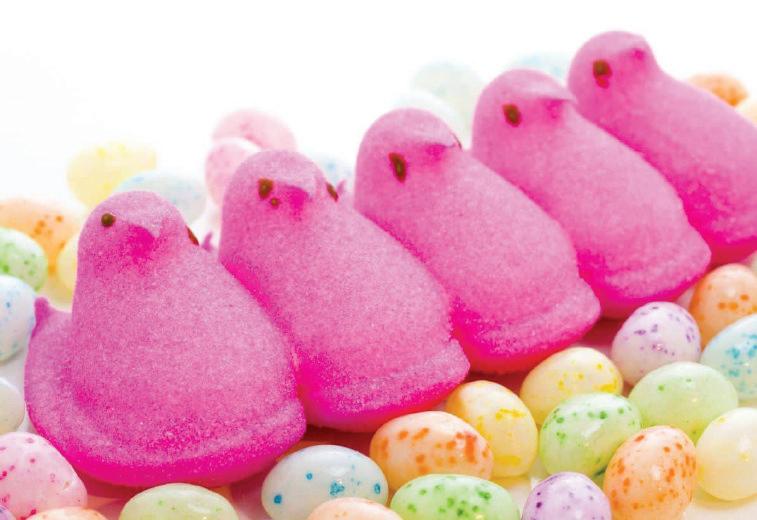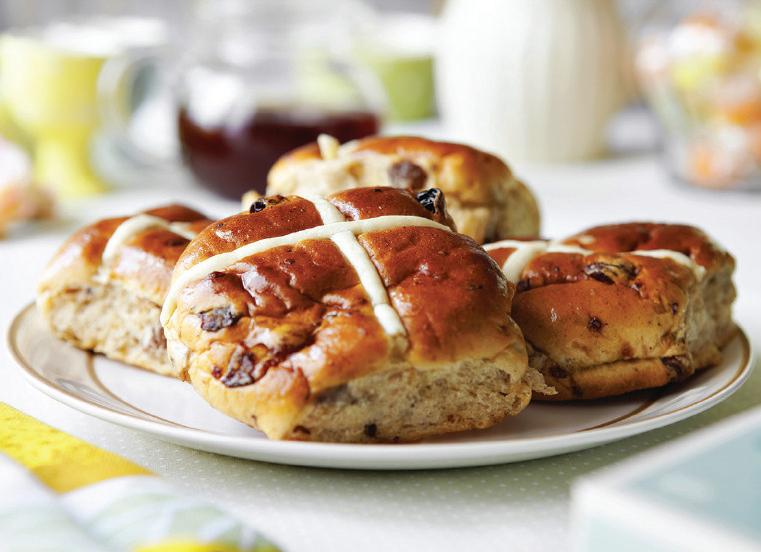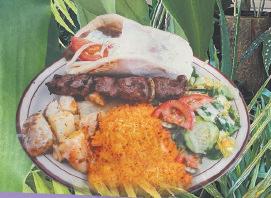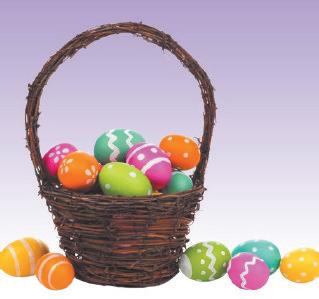



















































































































Hop on these tips for a great Easter egg hunt
METRO CREATIVE SERVICES
Egg hunts are a traditional component of many people’s Easter celebrations. Children often delight in searching for eggs around the house or in the backyard. Egg hunts are so popular that they have become a component of many town-sponsored festivities. In fact, the White House hosts its annual Easter Egg Roll each year.
There are many ways to make Easter egg hunts more enjoyable and productive for participants of all ages. Try these “eggcellent” ideas.
Designate a clear hunting area. Young children can grow frustrated searching for eggs in large areas. Set parameters for the search area that are manageable depending on the ages of the children participating. If you’ll be in a large yard or field, tape o the search area perimeter.
Vary the prizes. Candy, candy and more candy seems to be the name of the game on Easter. But too many sweets can lead to stom-
ach aches for young Easter celebrants. Instead, mix and match the prizes contained in the eggs. Candy can be in some, money in others, and perhaps small toys in a few eggs. Another clever idea is to mix the egg hunt with charades. Put charade prompts in some eggs so that kids have to act out what they read inside for added fun.
Special privilege egg. Hide one egg that gives the finder the opportunity for a special honor. It may include getting the first slice of the holiday ham or being able to choose a movie that the entire family watches together after dinner.
Label eggs for equity. When there are children across a wide range of ages, label the eggs with the children’s names or utilize a color-coded system to ensure that everyone has an equal shot at finding eggs.
Keep a master list. It can be hard to remember where each egg is hidden, so keep a running list of where they are or take photos with a phone of the hiding spots. This way you’re not left to discover a chocolate-filled egg teeming with ants come summertime.
Make custom baskets. Children will need something to carry their eggs. Prior to the egg hunt, let them decorate bags or baskets with Easter trinkets for custom creations.
Billions of Christians across the globe celebrate the resurrection of Jesus Christ on Easter Sunday, and that includes scores of children. Easter eggs figure prominently in children’s Easter celebrations, and the origins of this tradition are older than youngsters may realize. History.com notes that historians suggest Easter eggs can be traced to pagan traditions that considered eggs a symbol of new life. Decorating eggs is a wildly popular tradition among modern Easter celebrants, and this tradition also has a lengthy history. Some historians believe the decoration of eggs for Easter began in the thirteenth century, if not earlier. Some suggest eggs might have been forbidden during Lent, a 40-day period of sacrifice that precedes Easter. Eggs were decorated as Lent drew to a close and then eaten as part of Easter Sunday celebrations.
Easter egg hunts are a time-honored tradition. The opportunities for fun are endless when families plan accordingly.






















BY JESSICA HAGGARD Food Drink Life
Few Easter candies divide people quite like Peeps – 25% of Americans polled by Finance Buzz claim there’s no treat they love more. But 16% say they’d rather eat anything but the colorful, sugar-coated marshmallowy Easter staple, then there’s the Red Dye No. 3 controversy. Whether you’re a fan or a critic, there’s no denying that Peeps have become one of the most talked-about treats of the season.
Some love their sugary, marshmallowy goodness, but others can’t stand their artificial flavor and gritty texture. With changing consumer preferences and health concerns, is it time to say goodbye to Peeps, or will they remain a holiday staple?
A sticky sweet legacy: The rise of Peeps
Peeps have been around for more than 70 years, solidifying their status as nostalgic Easter treats. First introduced by Just Born in 1953, the original Peeps took a painstaking 27 hours to make by hand. Today, thanks to technological advances, the process takes just six minutes, allowing the company to churn out 2 billion Peeps every year according to the same Finance Buzz article.
METRO CREATIVE SERVICES
Easter Sunday is a significant day on the Christian calendar. Easter Sunday will be celebrated on April 20, and many of those celebrations will feature some notable traditions. Some traditions are undoubtedly familiar to practicing Christians, while others might come as a surprise. As Easter approaches, faithful Christians and others intrigued by the holiday can consider these notable traditions from around the globe.
Easter witches Witches are typically associated with Halloween, but they play a role in celebrating Easter in Finland. According to the Finland Promotion Board, Easter traditions in the northern European nation feature a mixture of religious references with customs related to the arrival of spring. It’s not unheard of for young Finnish children, particularly girls, to dress up as Easter witches the

pio del Carro (“Explosion of the Cart”) takes place in Florence, Italy. The U zi Gallery reports that this tradition can be traced to the First Crusade in 1099. During the first Easter in Jerusalem, Crusaders gave the blessed fire to the people as a symbol of purification. That custom has endured in Florence, where each Easter Sunday morning around 10 a.m. a candle is lit in the church of Santi Apostoli. That same candle is then used to light an antique cart loaded with fireworks, marking the beginning of a display that lasts around 20 minutes.
The Carpets of Semana Santa Carpets might not be the first thing most Easter celebrants think of when pondering the holiday, but that might be the case for anyone who’s ever spent the holiday in Antigua, Guatemala. Guatemala’s Semana Santa (“Easter Festival”) features detailed carpets
of colored sawdust adorning a Good Friday processional route. Preparation for the colorful and stunning display begins months in advance as the intricate carpets require ample time to produce.
Whips in the Czech Republic
Among the more unique Easter traditions takes place each Easter Monday in the Czech Republic. In adherence to this tradition, known locally as pomlázka, boys, and sometimes men, gather willow branches and braid them together into whips.
The whips are then decorated with ribbons before boys visit girls (or men visit women) who they know and lightly tap them with the whips. The tradition is believed to bring women luck, vitality and fertility. These are just some of the unique traditions many Christians adhere to as part of their Easter celebrations.

Over
flavors. Limited-edition varieties, like Peeps Hot Tamales, Dr Pepper and Cotton Candy, keep the
even for those who don’t love the traditional marshmallow flavor. Yahoo News said that Peeps launched three new flavors – cookies and cream, tropical punch and chocolate pudding – giving new Easter basket ideas for teens, kids and even adults.
Flu y fun or sugary nightmare?
For many, Peeps are a nostalgic must-have. The chewy texture, sugary crunch and bright colors are reminiscent of childhood Easters filled with egg hunts and baskets brimming with candy.

“I didn’t give a peep about Peeps as a child, but now that I’m solidly middle aged,
these sugar-coated, unnaturally colored marshmallow candies are an essential part
for Easter – they’re a yearround tradition. Osborn reports, “I celebrate every holiday with Peeps – not just Easter. There are Valentine’s Peeps, Ghost Peeps for Halloween and Reindeer Peeps at Christmas, and the possibilities are endless.”
Beyond snacking, Peeps have become a playful ingredient and decoration. They float as festive cocktail garnishes, get dipped in chocolate and even face o in microwave battles with toothpick swords. They also make a great addition to Easter charcuterie boards and make for colorful props for Easter photoshoots.
However, not everyone is a fan. The hosts of “Good Mythical Morning,” a popular YouTube talk show with over 19 million subscribers, tried every flavor of Peeps and shared that the candy came in second in their Worst Easter Candy Tournament. Michelle Price of Honest and Truly also shared her sentiments about the Easter treat saying, “I like marshmallows, but Peeps aren’t marshmallows. They’re a nasty candy masquerading as marshmallows. They’re cute and fun, but they do not taste good.”
instead? Bake and decorate them with the kids – they’ll remember this more than having a basket full of storebought candy.
“There are so many healthier, homemade and naturally sweetened treats to enjoy for Easter. My kids don’t need neon-colored marshmallows filled with questionable ingredients to celebrate the holiday,” Tsaturyan adds.
The internet’s love-hate relationship with Peeps
Despite the controversy, Peeps continue to be a pop culture phenomenon. They regularly trend on TikTok and social media, where users debate whether they’re delicious or disgusting.
A TikTok video uploaded by @ggflavour shows her enjoying pink Peeps, while another TikTok video created by @3sunzzz shows her disgust with the new Peeps Delight flavor she tried. Viral Peeps challenges – where people microwave them to see how big they expand or freeze them to test their texture – have fueled their continued relevance.
































She continues, “That said, I have one kid who likes them and one kid who does not, so I’ll support the child who enjoys Peeps and put them in the Easter basket. They do make fun decorations for Easter desserts, but that’s it – they get thrown away after the meal. Even my kid who likes them can only eat so much!”
Peeps have also made headlines for their unexpected collaborations. According to News-Press, Milk-Bone, maker of dog treats, has recently teamed up with Peeps and released marshmallow-flavored dog treats for Easter this year. The dog biscuits come in three shapes, the classic bone, the iconic Peeps bunny and a chick, all of which are in festive spring colors.































The future of Easter’s most divisive treat












Peeps aren’t just controversial for their taste – some of their ingredients have raised health concerns. The candy has been criticized for containing Red Dye No. 3, a food coloring linked to potential health risks and recently banned in cosmetics. After mounting pressure, abc27 News recently reported that Just Born will remove the Red No. 3 dye from all Peeps products. But for some parents, the damage was already done.
“As a mom who prioritizes a healthy lifestyle, I would never buy my kids Easter Peeps,” says Tamara Tsaturyan of Thriving in Parenting. “They’re nothing but artificial colors, corn syrup and preservatives – things I actively avoid in our home. The fact that some varieties were banned due to Red Dye No. 3 just proves how problematic they are. If a chemical is too risky for certain states, why would I want my children eating it?”
Beyond artificial dyes, USA Today has reported that each Peep contains a high sugar content, with one serving packing over 34 grams of sugar – more than a can of soda. While indulging in Easter candy is expected, why not try a homemade treat like peanut butter brownies this year

Despite growing health awareness and evolving tastes, Peeps aren’t disappearing anytime soon. Their ability to reinvent themselves with new flavors, partnerships and even craft projects, like Peeps dioramas, has kept them relevant. Each Easter, Peeps continue to be one of the top-selling seasonal candies. While some may cancel them from their own baskets, millions of others still reach for these sugary chicks year after year.
Final verdict: Keep or cancel?
Peeps may be one of the most polarizing Easter candies, but their longevity speaks for itself. While some will never acquire a taste for the sugary marshmallow treat, others will always associate them with childhood traditions and Easter fun. Love them or hate them, Peeps aren’t hopping away anytime soon.
Jessica Haggard is dedicated to helping people cook easy everyday recipes focusing on bioavailable and nutrient-dense foods. She helps people overcome food allergies and discover healthy recipes that make a di erence in their health with gluten-free, low-carb and keto cooking at Primal Edge Health.









METRO CREATIVE SERVICES
The Lenten season marks a period of 40 days when faithful Christians prepare for the glory of Easter Sunday. Easter commemorates the miracle of Jesus Christ’s resurrection, which is foundational for the Christian faith.
Lent is a season when Christians reflect and prepare to celebrate Easter. Lent is a period of spiritual purification that begins on Ash Wednesday and ends on Holy Thursday. Fasting, giving alms and prayer are some of the hallmarks of Lent.
Many Lenten traditions are well known, but others are not. Here’s a glimpse at some of those traditions.
The first ‘Lent’ Lent is based on the 40 days that Jesus spent in the desert in preparation for his public life. Matthew 4:1-11 shares that Christ was led into the desert by the Holy Spirit for a period of fasting and prayer, where He constantly encountered the devil and his temptations.
Lent also mirrors the period of time (40 days) that the Israelites spent in their journey from slavery in Egypt to the promised land of Israel.
Black fasts
While certain Lenten restrictions have lightened up a bit in recent years, it once was the norm to consume a single meal per day of bread, water and herbs after sunset on Ash Wednesday and Good Friday, which was known as a black fast. During the other days of Lent, no food was allowed until 3 p.m., which Christians believe was the hour of Our Lord’s death.
Piñatas for Lent?
The Lenten tradition of hitting a papier-mâché creation filled with candy originated in Italy. Eventually the idea was picked up by the Spanish and brought to Mexico, where the familiar piñatas now known to partygoers across the globe appeared. Professor Michael Foley, author of “Dining with the Saints,” says the original piñata had seven cones to
represent the seven deadly sins. Hitting the cones and defeating the sins revealed the heavenly reward in the form of candy.
Prayerful pretzels
In the early Middle Ages, when other foods were not allowed during Lent, pretzels became popular. The twisted shape of the pretzels was associated with arms entwined in prayer.
Hot cross buns
Hot cross buns are synonymous with Easter. Although they may predate Christianity and might have been a tradition adopted to make Christianity more relatable to the masses, one legend suggests they originated with a twelfth century Anglican monk. This monk reportedly baked the buns and marked them with crosses in honor of Good Friday. These yeasted sweet rolls have since become a popular treat on Easter weekend.
Lent precedes Easter each year and is full of time-honored traditions.

































































































































































METRO CREATIVE SERVICES
Tradition features prominently in Holy Week celebrations. The week leading up to Easter Sunday, Holy Week is a sacred time for faithful Christians. The Stations of the Cross are one of the traditions that many Christians feel bolsters their faith and brings them closer to God.
What are the Stations of the Cross?
According to Catholic Online, the Stations of the Cross are a 14-step devotion that commemorates Jesus Christ’s last day on Earth as a man. Each of the 14 stations focus on a specific event of Jesus’s last day as a man.


Where can the Stations of the Cross be found?
Stations of the Cross are typically found in churches. Many times the Stations adorn the interior wall of a church, and Catholic Online notes they’re often depicted using small icons or images. Some churches with sizable exterior grounds may arrange larger Stations along footpaths in yards or gardens on the premises.
When do people most commonly pray the Stations of the Cross?
Lent is the most common time to pray the Stations of the Cross, and some churches hold weekly prayer sessions on Wednesdays and Fridays during this time of year.
What are the 14 Stations?
Catholic Online notes the 14 Stations of the Cross are:
1. Jesus is condemned to death.
2.
3.
4.
5.
6.
7. Jesus falls a second time.
8. Jesus meets the women of Jerusalem.
9. Jesus falls a third time.
10. Jesus’s clothes are taken away.
11. Jesus is nailed to the cross.
12. Jesus dies on the cross.
13. The body of Jesus is taken down from the cross.
14. Jesus is laid in the tomb. The Stations of the Cross are an important Easter tradition that shed light on Jesus’s resurrection. Individuals interested in praying the Stations of the Cross are urged to contact a local church so they can engage in this moving Christian tradition.Lent precedes Easter each year and is full of time-honored traditions.
